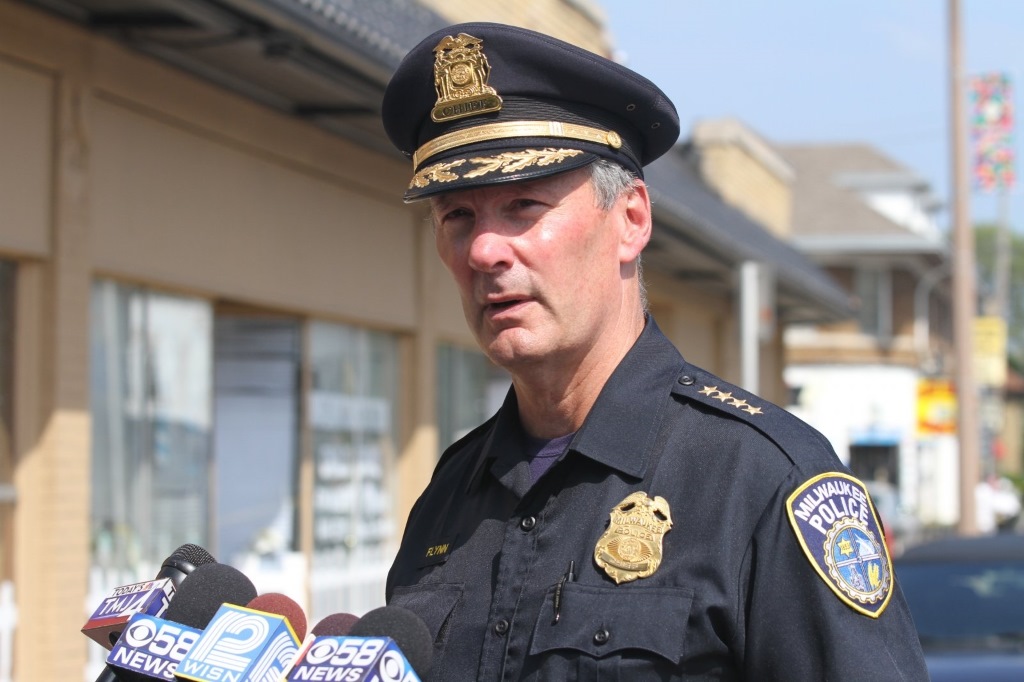Should Cops Do More High Speed Chases?
Common Council says yes. Chief Flynn says no. Who’s right?
Milwaukee Police Chief Ed Flynn still vividly remembers an incident that happened on his first job as a chief, in Braintree Massachusetts.
“Two police officers were chasing a speeder and on a curve in the road they lost control and hit an oak tree,” he recalls. “They were killed instantly. These were two young men with kids and I had to tell their wives they were widows.”
High-speed chases can be very dangerous for police. More cops die in car accidents than from shootings, onn study found.
About 40 percent of all police pursuits of fleeing offenders in cars end in a crash, studies have found, and of these, 20 percent cause traumatic injury, and 1 percent result in death. In an average year more than 320 Americans are killed as a result of police pursuits, and one-third of those deaths involve innocent bystanders: uninvolved drivers, pedestrians, and cyclists.
“I’ve been wrestling with the pursuit problem my entire career,” Flynn says.
In 2010, Flynn changed the policy after four innocent people were killed by drivers fleeing police between Dec. 31, 2009, and March 1, 2010. “If we’re going to risk the lives of cops and citizens,” he says, “then it ought to be a pursuit of someone committing violent crimes.”
Under the new policy, police needed “probable cause” to believe the suspect had committed a violent crime, otherwise there should be no pursuit.
The new policy had quick results. The number of pursuits dropped from 167 in 2009 to 68 in 2010. A recent Fire and Police Commission (FPC) report on police pursuits shows the data goes back to 2002 and there was an annual average of 211 pursuits from 2002 through 2009, which dropped to 70 per year from 2010 through 2014.
In 2015, USA Today did an in-depth story on the problem of police pursuits, and used Flynn as a spokesperson for the need to have some limits on pursuits and Milwaukee police union chief Mike Crivello as a critic of such policies. “When crooks think they can do whatever they choose, that will just fester and foster more crimes,” Crivello complained.
Ald. Bob Donovan, who typically echoes the views of the union, began taking up Crivello’s argument in April 2015, arguing the restriction on pursuits had led to more car thefts. “These criminals are literally thumbing their noses and flipping off officers as they drive off, knowing that officers will not pursue them,” he charged.
Donovan, as it happens, was running for mayor and the incumbent Tom Barrett may have feared it was a potent issue. Or maybe it was simply that Flynn had seen enough data from the field to move to amend his policy: “In 2012 and 2013 we saw a big increase in stolen cars and car jackings — we hadn’t seen that level of car jackings since the 1990s,” he says.
Whatever the reason, in June 2015 the chief announced a new policy: If either the individual or the car being driven has been involved in a violent crime, including car jackings, police can pursue the car.
The result was a significant increase in pursuits, to 263 in 2015 and 306 in 2016 — more pursuits than in any year since 2002, when there 271 pursuits, the FPC report show. There was also a drop in pursuits resulting in accidents: down from more than 40 percent resulting in accidents in 2007 through 2009 to about 26 percent in 2015 and 2016.
And yet the department was also seeing an increase in non-pursuits, which Flynn now requires officers to record. In 2016 there were 4,317 non-pursuits. Both pursuits and non-pursuits have been rising. Officers recorded 27 pursuits and 1,675 non-pursuits in the first quarter of this year, or more than 500 non-pursuits per month, as Ashley Luthern reported for the Milwaukee Journal Sentinel.
This, of course, has Donovan again calling for more police pursuits. A recent press release by him noted that Kansas City, KS, reversed course and relaxed its restrictive policy on pursuits.
But nationally, “Almost all U.S. law enforcement agencies have adopted a restrictive pursuit policy, according to the International Association of Chiefs of Police,” as a story in Popular Mechanics noted. “About one-fifth of police departments allow pursuits only for felony offenses, while half require the pursuit to end when the suspect has been identified.”
Donovan was until recently one of the few council members pushing for more pursuits. But last month the council made a surprising reversal, with 13 of 15 members (all but Alds. Milele Coggs and Terry Witkowski) signing a letter asking the Fire and Police Commission to “direct the chief” to “redraw” his pursuit policy.
Just as surprising was the leader of this revolt: Michael Murphy, the low-key, policy-oriented alderman who served a term as a very effective council president. Calling it the “No. 1 issue” raised by residents in his district, Murphy told Lutheran “I am fearful for the people of the city of Milwaukee. We’re all looking for one thing — changing behavior — and trying to find solutions.”
The letter from council members noted that three more Milwaukee residents were recently killed by hit-and-run drivers, bringing the 2017 total to eight. They also claimed that speeding, red light-running and reckless driving have been occurring at record levels.
But Police Inspector Michael Brunson told Common Council’s Public Safety Committee their proposal was the wrong way to go, the JS reported. “If we do relax this policy, I don’t think there’s any doubt you’ll see additional injuries and deaths on our city streets,” he said.
The FPC report shows a disturbing trend: The median age of those fleeing the police has dropped from 33 years old in 2007 to 18 years old in 2016, and the percent of chases at speeds greater than 75 MPH rose from 13 percent to 48 percent during that period. As the study noted, “The number of pursuit subjects age 18 and younger is found to strongly correlate with both the number of pursuits above 75 mph and the number of 3rd party injuries that result from vehicle pursuits.”
On the one hand that suggests the streets are getting more dangerous. On the other hand, asking police to do even more of these kind of pursuits sounds risky. And Flynn notes that it will generally be for naught, because the offenders rarely get any jail time. “No one goes to jail for a stolen car,” he notes. “We can be risking death to apprehend them. Some of this is criminals wanting us to chase them because they want to play Grand Theft Auto, and they know they will only get probation when they’re caught.”
Donovan and others claim that perpetrators have become emboldened because they know the police won’t chase them. Flynn reverses the blame, saying “a couple of alders insisted on calling it a non-pursuit policy. I think they did as much as anyone to make criminals think we weren’t going to pursue them.” (In the Canadian city of Victoria the changes made in the police pursuit policy are kept a secret.)
Meanwhile the Milwaukee policy have been adopting new technology developed by a private company called Star Chase, whereby police shoot at GPS “bullet” about the size of a soup can that can stick to a fleeing car if fired from a distance of two car lengths or less. A 2014 report found it is effective in 55 percent of cases, meaning it sticks to a car and an arrest is later made.
“We’re like the star pupils for that company,” Flynn says.
“During the year 2016 MPD deployed this technology 156 times, successfully attaching it to fleeing vehicles 112 times,” the FPC report found.
Council members might want to give this technology more of a chance to see its impact. The council might also ask Flynn to speak to them about the issue. “I think there are a lot of misperceptions out there,” he says.
Instead the letter from the council says “we think that after seven years it (is) only appropriate that a review of such an important policy be conducted,” ignoring the fact that the policy was changed, just two years ago and has resulted in very different outcomes.
On the other hand the letter is diplomatic, asking the FPC “to gather facts, ask questions, and perform your full due diligence, and ask the basic question: Is or is not the current form of this policy in the best interest of the community?”
That’s an effort well within the purview of the FPC, and on an issue that is clearly of great importance.
If you think stories like this are important, become a member of Urban Milwaukee and help support real independent journalism. Plus you get some cool added benefits, all detailed here.
More about the Pursuit Policy
- MPD investigates a fatal crash - Milwaukee Police Department - Jun 2nd, 2020
- Op Ed: City Should Change Police Pursuit Policy - Jonathan Farris - May 27th, 2019
- In Defense of MPD’s Pursuit Policy - State Rep. Bob Donovan - Apr 25th, 2019
- Murphy’s Law: Are Police Pursuits Out of Control? - Bruce Murphy - Apr 25th, 2019
- City Officials Promote Police Pursuit Policy - Ximena Conde - Jun 26th, 2018
- Murphy’s Law: Should Cops Do More High Speed Chases? - Bruce Murphy - May 26th, 2017
- Kansas City, KS reverses pursuit policy to address “skyrocketing crime - State Rep. Bob Donovan - May 15th, 2017
- Fire and Police Commission Releases Report on Police Vehicle Pursuits - City of Milwaukee Fire and Police Commission - May 10th, 2017
- Thirteen Council members demand action from MPD, FPC - State Rep. Bob Donovan - Apr 20th, 2017
- James Methu’s Statement on Public Safety in Milwaukee - James Methu - Jan 25th, 2016
Read more about Pursuit Policy here
Political Contributions Tracker
Displaying political contributions between people mentioned in this story. Learn more.
- March 28, 2016 - Michael Murphy received $100 from Terry Witkowski
Murphy's Law
-
The Last Paycheck of Don Smiley
 Dec 17th, 2025 by Bruce Murphy
Dec 17th, 2025 by Bruce Murphy
-
Top Health Care Exec Paid $25.7 Million
 Dec 16th, 2025 by Bruce Murphy
Dec 16th, 2025 by Bruce Murphy
-
Milwaukee Mayor’s Power in Decline?
 Dec 10th, 2025 by Bruce Murphy
Dec 10th, 2025 by Bruce Murphy























Turns out high speed chases, the successful ones that do not end in a crash and apprehend the subject, raise the adrenaline levels in the police to levels beyond the point where their vision and judgement are severely impaired (there is a lot of research on this). The Rodney King episode is a good example of what can happen after driving through a city at 80 – 110 mph, and I think was part of their defense.
In other words, high speed chases make it very difficult for police officers (humans) to make split second decisions or any good decision which is essential for their jobs and the public’s safety.
Seeing how the drug trade works with big SUV’s filled with heroin/fentanyl/Pot that is how the system works. They just speed away. No more drug houses that everyone can rat on.
With he Pot legalization and tolerance this si going to increase tremendously the next decade till we go the way of Viet Nam and execute sellers.